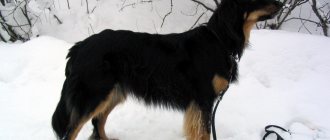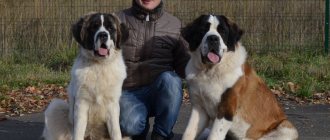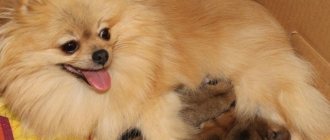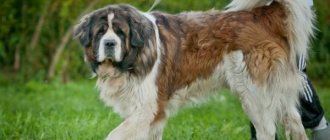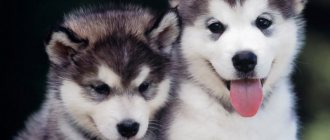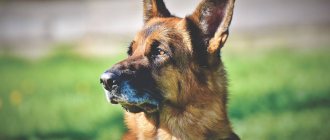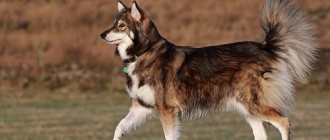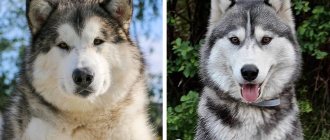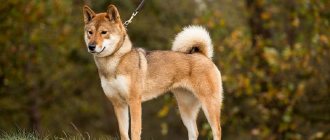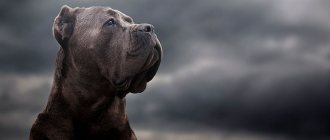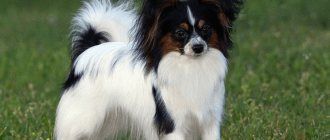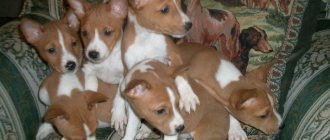Breed standard and description
Height at withers: males 63-70 cm, females 58-65 cm; Weight: 35-45 kg.
- Color: black, black and tan, fawn;
- Coat: thick, smooth, longer and wavy on the belly, back of the legs and bottom of the tail;
- Skin: pink;
- Head: skull equal in size to the muzzle;
- Eyes: medium size, eyelids tightly fitting, black;
- Eye color: from light to dark brown;
- Nose: black, brown in light-colored individuals;
- Mouth: black lips, close-fitting, triangular teeth, scissor bite;
- Ears: not cropped, hanging freely, reaching the corners of the lips, directed forward when interested;
- Neck: smooth transition to the shoulders and back, the skin does not sag;
- Chest: deep and wide;
- Back: straight, lower back not arched, croup slightly sloping down;
- Legs: straight, parallel, with well-defined knee joints, metacarpus, black toes;
- Tail: not docked, at rest below the knee.
Permissible deviations from the standard
- Bite: pincer-shaped;
- Skin: gray or bluish tint;
- Color: lightening of the fur on the belly in fawn individuals, a small white spot on the chest and isolated white hairs on the tip of the tail and toes in black and tan.
History of the Hovawart breed
The homeland of Hovawarts is Germany. The first mention of this breed dates back to the 13th century. In those days, the dog performed guard duties at castles, belonged to the elite among its relatives, and reproduced while maintaining the purity of its origin.
Over time, the livestock increased, and they began to be used to help herd the herds of the castle owner. Representatives of the breed arrived on peasant farmsteads later, where they soon disappeared among the numerous descendants from mixed breeding.
At the end of the 19th century. the breed is mentioned in books about German dogs, and already in the 20th century. interest in Hovawarts was revived in their homeland. The breed was recreated in 30-35 years. The material for selection was selected from peasant farms, where dogs were used as shepherds and watchmen . At the end of the 30s, work was suspended due to the outbreak of World War II. They were continued in the middle of the century, and by 1959 in Germany the breed was recognized as a service breed.
Hovawarts were internationally registered in 1964, and in 1983 the International Hovawart Federation appeared.
Story
Individuals of this breed were first mentioned in the chronicles of 1274, but in the other history of these dogs there is complete confusion. It is likely that this group of dogs originated much earlier, even before the 8th century. There is information about the Molossians who accompanied the tribes in the territory that Germany occupies today. It should be noted that these tribes were characterized by the presence of a warlike disposition, and animals helped people not only in everyday life, but also during battles.
According to an alternative version, representatives of the breed act as a project of the elite of an ancient society. To put it simply, these dogs were deliberately bred in closed circles, and in an unusual way they ended up around commoners. A feature of these animals, which was introduced in the 17th century, is the ability to independently make any decisions in unforeseen situations. It is this characteristic that puts representatives of the breed in elite positions in the world of dogs and at the same time creates a number of difficulties in the process of education.
Temperament and character
These are dogs with a strong active temperament; if properly kept and trained, their behavior is predictable and does not cause inconvenience to their owners.
Positive qualities of the breed:
- Good health - there are no hereditary diseases, and therefore no signs of degeneration;
- Endurance – adaptation to the environment is excellent;
- High and universal working qualities - protective habits are inherent in nature;
- Devotion to a person is inherited and easily instilled through communication;
- Accommodating character and flexibility.
Problematic behavior:
- Long puppyhood and adolescence – until about 3 years of age, character and behavior are formed, unpredictable activity is possible;
- The need for the owners to comply with the regime throughout the dog’s life - the owner (and each family member) must become the dominant male in the pack;
- They do not tolerate separation from their owners well - problems arise when they leave and need to stay for long periods of time.
Dog and man
Hovawarts are easy-going in the family and, with a properly organized hierarchy, get along well with members of the household, including animals. Dominance is in their blood, but they take leadership in relation to other pets of their owners for granted, without actively proving it.
Devotion to the owners manifests itself early, and this quality is quite enough to build on it the right relationship without violence. The pet quickly gets used to the regime moments.
It is undesirable to leave immature puppies alone with small children: without malicious intent, a dog can cause physical pain to a child by accidentally pushing or vigorously wagging its tail. Adults protect children and, at the slightest threat (real or perceived), they zealously defend them.
Maintenance and care
Conditions of detention
Representatives of the breed are unpretentious to conditions, get used to what they have, put up with the lack of comfort, but require attention.
Hovawarts can live both in a city apartment and in a country house . It’s good if there is a permanent place in the yard. They tolerate frosty winters well; in summer it is advisable to arrange a booth in a shady place.
The main thing is communication with the owners. Under no circumstances should you put your Hovawart on a chain or keep him in an enclosure all the time.
Sufficient physical activity is important for them . Young puppies frolic energetically in the fresh air, and adults are able to take long walks with their owner. It is necessary to find an opportunity and a place where the dog will be released from the leash.
Regular (twice a day) walks for at least 2 hours until tired are the key to a good relationship with the owner, proper physical development, and a stable mental state.
Feeding
The diet of a service dog should be varied and balanced. Cereals, vegetables, eggs, fermented milk and meat products should be present in the diet when cooking at home. Vitamin supplements are given only on the recommendation of a veterinarian.
It is possible to feed only dry food that is suitable in composition and age. Recommendations from professionals will also come in handy when choosing a brand.
Regardless of feeding method, the dog is provided with clean water around the clock.
Grooming
Hovawarts have a low wool matting rate, so during the period between molts they can’t be scratched every day. But this procedure helps training and calms the dog, so many breeders do not neglect it. In the warm season, this is also a preventive measure against ticks entering the skin. The fur is not cut, except in the toe area.
Healthy skin is an important indicator of well-grooming.
You should inspect your pet’s ears every day: if blockages or discharge are detected, they are cleaned with a cotton pad with oil or a disinfectant solution.
The eyes are washed as needed: if discharge or dried crusts appear, treat the eyelids with a weak infusion of tea or a decontaminating solution.
Character traits
Representatives of this breed are very intelligent and have all the qualities of a leader.
In critical situations, such dogs are ready to zealously protect people and homes.
Pets are quite active and need regular walking and playing in the fresh air. It is not recommended to leave your pet alone with a child, as the animal may inadvertently cause harm to him. Being quite large in size and playful, the dog can accidentally knock a child down.
Due to its independent nature, this breed requires proper training. Otherwise, the puppy may grow into a disobedient and unbalanced dog.
However, it should be remembered that even those individuals who are well brought up and trained, for the most part, when making decisions, will be guided by their own opinion, and not by the owner’s command.
The dog will love every member of the family, but consider and obey only one as the owner. In your relationship with your pet, it is important to show love and respect, otherwise the animal may become very offended and even withdraw into itself.
Hovawarts easily tolerate changing places, so you can take them with you on vacation. In the company of other animals, representatives of this breed will clearly show leadership qualities and defend their territory. Therefore, Hovawarts can easily get along only with representatives of those breeds that, by their nature, do not strive to take a leading position.
A person who has decided to get a Hovawart needs to remember that each individual can have individual character traits.
Also, the pet’s behavior may not meet the general standard due to improper upbringing. However, such dogs will have a protective instinct in any case, since it is inherent in nature.
Psychology
Hovawart has a peaceful disposition and friendliness. Often such dogs are used not only to protect homes, but also as a therapy dog or assistant for a disabled person.
The Hovawart boy is a born leader and an excellent guard.
Hovawart character benefits:
- It has pronounced territorial behavior, so since ancient times it has been mainly used as a yard guard.
- Highly trainable, but may require patience. This is due to the fact that it matures somewhat later than other breeds.
- He has a strong character, is self-confident and is always devoted to his loving owner.
- Despite constant vigilance and attentiveness, the Hovawart is balanced and calm.
This is a very active dog and walks of 10 minutes are not suitable for her.
Important! Living in an enclosure or on a chain are the two worst solutions for a Hovawart.
The character of males and females has significant differences. Girls learn much faster and respond more quickly to what they are taught. They are much more cunning than boys and can do mischief.
When walking, females respect the authority of other dogs and try less to be leaders than males. At the same time, boys are more disciplined and carry out the owner’s commands much faster.
We can say that boys are kings who show everyone that they are in charge, while girls are little princesses.
An interesting fact is that in the first three years of life, the Hovawart behaves like a puppy. However, unlike some other breeds, such as the Labrador and Border Collie , he does not seek interaction with strangers at all.
Appearances are deceptive. Unlike other guard dogs, the Hovawart looks very cute
The whip is completely unsuitable for training and education of this breed. The best solution is praise and carrots. After all, the dog will not tolerate aggression and will respond accordingly.
Also, it is worth noting that Hovawarts are touchy. If the owner goes too far, the dog will withdraw. In this case, the owner needs to be the first to meet the world halfway.
Hovawart and children
The Hovawart exhibits all the virtues of a companion in behavior and character. Shows affection and care towards children. A strong nervous system and balanced character allow you to ignore children’s pranks.
If children make Hovawart nervous, he will simply get up and leave. However, Hovawarts are great at distinguishing between play and bad attitude. If a child allows himself to kick or hit a pass for his own amusement, then this should be stopped immediately.
If such situations continue and the hovawart understands that the situation is not changing, then the dog will begin to independently build a relationship with the child, which can lead to painful consequences for the latter.
Children should not be allowed to walk with a Hovawart on a leash. This moment is individual for everyone, but even adults cannot always hold a dog. But you shouldn’t overestimate the Hovawart’s friendliness towards children and leave them alone. The Hovawart is a large and strong dog; when playing with children, it can be carried away with one tail.
Education and training
Hovawarts have very high trainability. Learning basic concepts (“place”, “to me”) begins with the appearance of a dog in the house. More serious job skills are instilled from 8-12 months.
Obedience cannot be achieved through intimidation and cruel treatment - the breed is focused on submission to humans, and with a properly organized lifestyle, problems do not arise.
In addition to daily walks in the warm season, outdoor water procedures will be a good means of development. Hovawarts love to swim.
If you have problems with training or when planning to participate in exhibitions, it is recommended to contact professional trainers.
Origin story
The history of the breed goes back hundreds of years. The first mentions of such dogs are found in the German chronicles “Der schwabenspiegel” (1274). The events described in the book took place in 1210. When the Ordensritterburg fortress was besieged by northern tribes, the owner of the castle entrusted the rescue of his small child to a dog. He tied the baby onto the Hovawart's back and released him outside the castle. The faithful dog not only saved the heir, he returned with help. The child's name was Eike von Repkow. Having matured, he considered it necessary to record this fact in history.
The name Hovawart is supposedly formed from two words: hof (yard, estate), wachter (guard, watchman).
In the 15th century, dogs called Hovawarts were on the list of the most revered breeds in Germany. Since the Middle Ages, the breed has experienced ups and downs, but has never been completely forgotten. Hovawarts are regularly mentioned in canine literature throughout the entire period of their existence. A huge role in the history of the breed was given to Kurt and Bertram Koenig, father and son, who at the beginning of the 20th century began restoring the breed. The work took place in several stages.
In 1915, breeders selected strong peasant dogs that became the genetic core. Then, with the meticulousness characteristic of the Germans, they began to refine the appearance and consolidate the desired features. According to some sources, Leonberger, Newfoundland, and Kuvasz also took part in the formation of the breed. Already in 1922 the first nursery was registered. By 1937 the stud book contained records of 125 litters. The breeding program could be considered almost complete, but World War II made its own adjustments. The livestock was almost completely destroyed and began to recover only in 1949. In 1959, Germany officially recognizes the Hovawart breed and gives it the status of a service dog. The FCI recognized the Hovawart as a service breed in 1964. As a result, he receives international recognition.
Video review about the Hovawart dog breed
Health and life expectancy
Representatives of the breed live on average 13 years . Dogs whose lives are organized correctly live longer, remaining healthy and active into their old age.
This is a natural, naturally formed breed. Therefore, she does not have the illnesses that plague others. Immunity is good, resistance to diseases in a well-groomed individual is high.
Hovawarts are vaccinated against distemper, hepatitis, rabies - these viruses do not spare anyone.
Similar breeds
The Hovawart can be mistaken for another breed, a mixed breed or a mongrel. Who is he similar to and what is the difference:
Golden retriever
The fawn representative of the breed is most often confused with a retriever, but these are completely different dogs. Distinctive features of the Hovawart: longer limbs, tail - in mood, raised up and curved towards the back, leadership instinct is more developed, strong will;
Photo: wikimedia.org
Bernese Mountain Dog and Leonberger
Hovawart is more athletic, flexible and slender, alert and temperamental;
Photo: wikimedia.org
Newfoundland
The German watchdog does not like being in the water so much, it is much more temperamental and playful, and is distinguished by its smaller size and amount of fur.
Photo: flickr.com
Breed photo
A selection of photos of Hovawarts.
Add a comment Cancel reply
